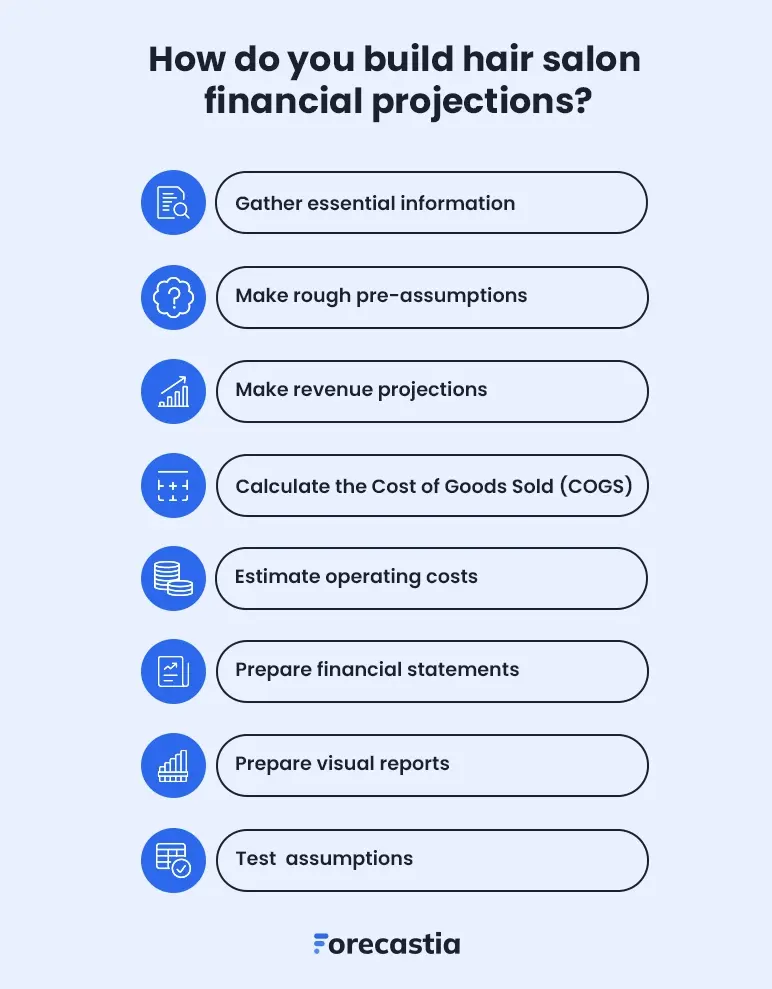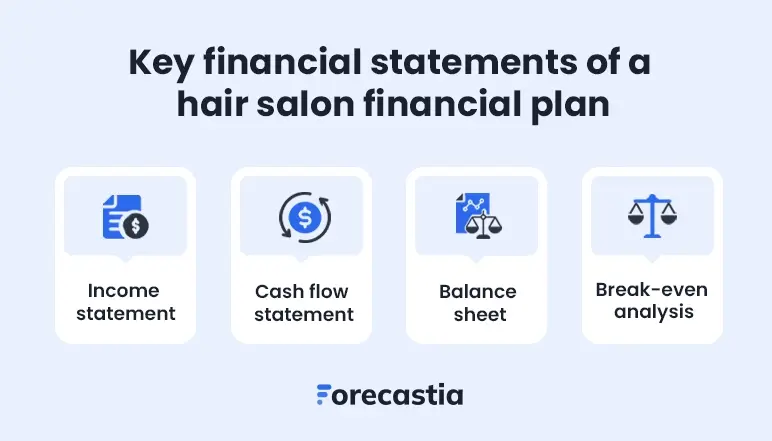Your salon is always buzzing—appointments, styling, and happy clients.
But behind the scenes, there's a whole lot of cash flow chaos happening due to rising supply costs, slow seasons, and surprise expenses, which can cut your profits.
That’s where a hair salon financial plan comes in. It helps you keep everything running smoothly—from tracking costs of products and payroll to forecasting revenue and managing cash flow.
Need help build your financial plan?
Don’t worry! This guide will walk you through the key steps to creating a strong financial plan.
How do you build hair salon financial projections?
Creating realistic financial projections for your hair salon involves thorough analysis and meticulous planning to comprehend its financial health and growth potential.

Here’s a step-by-step guide to help you build accurate and actionable projections while ensuring you factor in every detail:
1. Gather essential information
First, collect all the relevant key data that lays the groundwork for accurate financial projections.
This would include your hair salon details like:
- Current operations
- Target demographics
- Historical financial performance
- And industry benchmarks.
Start with your sales data—Analyze daily and weekly revenue trends, peak booking times, and how demand shifts with seasons. For a new hair salon, analyze the latest market trends, industry benchmarks, and local competitors to make educated estimates.
Further, understand your customers inside out.
- Who are they?
- What services do they prefer?
- How frequently do they visit?
Then, track inventory data—monitor product usage, stock levels, and supplier costs to accurately calculate expenses. Hair salons rely on products like shampoos, hair dyes, and styling tools, so understanding turnover rates helps in budgeting and cost control.
Most importantly, don’t forget to evaluate the past performance data of your hair salon to understand what drives your business.
Also, analyze previous revenues, costs, and profits to detect trends and highlight the areas for improvement. Check how some of the marketing campaigns, promotional offers, service bundles, or seasonal trends impacted your sales and cost.
That’s how you'll have everything you need to create accurate and actionable financial projections.
2. Make rough pre-assumptions
Now, make some preliminary assumptions for your hair salon’s financial projections based on gathered data. Such estimates will outline your business's revenues, expenses, and profitability levels.
Start by focusing on the basics: How much you’ll make in monthly sales, how much customers will spend on average, and what your operating costs might look like.
Use insights from past sales trends, industry benchmarks, and your own market research. Also, consider factors like seasonal demand shifts, upcoming service offerings, or trending hairstyles that could impact your revenue projections.
Here are a few key metrics to consider while making your assumptions:
- Revenue growth: Predict a percentage increase in sales, such as a 5% annual growth based on an expanding customer base or marketing efforts.
- Cost increases: Account for potential rises in product costs, staff wages, or utility bills, such as a 10% increase in electricity costs during peak summer.
- Seasonality: Consider busy periods like wedding season and holidays, as well as slower months such as January, when fewer clients book salon appointments.
- Economic conditions: Account for inflation, rising wages, or other economic factors that may impact both costs and customer spending power.
Don’t aim for perfection—these are rough estimates to guide your planning that will evolve over time. So, revisit them periodically as actual data comes in.
3. Make revenue projections
Revenue projections are all about figuring out how much money your hair salon might make.
To get started, think about a few simple things: how many clients you can serve per day, how often appointments are booked, and the average spend per client on services and products.
Breaking it down step-by-step makes it easier to see your earning potential.
If your hair salon has 5 chairs, serves an average of 6 clients per chair per day, and the average spend per client is $60, here’s the math:
5 chairs × 6 clients × $60 × 30 days = $54,000/month
But you’ll also need to factor in seasonality, weekends, and special events—these can bring in more clients and boost your revenue. On the flip side, slower months or weekday lulls might lead to lower income.
Additionally, consider other revenue streams. Offering premium services, retail product sales, bridal or event hairstyling, and membership packages can add a significant percentage to your overall earnings.
By including these extra streams, you’ll get a more accurate picture of what your hair salon can earn.
Revenue projections aren’t merely a dry exercise of crunching numbers—they set realistic expectations while preparing for both the busy times and the quieter ones.
4. Calculate the Cost of Goods Sold (COGS)
The next step is to calculate your Cost of Goods Sold (COGS)—essentially, the direct costs of providing your salon services. This includes hair products, dyes, shampoos, styling tools, and other materials used for treatments.
Here's an easy way to do your COGS calculation:
List the products: Write down all the materials used for each service, from hair color and shampoos to styling creams and foils.
Find the costs: Check invoices or supplier receipts to determine the price of each product.
Calculate per service: Determine the cost per haircut, color treatment, or styling session. (i.e., if a hair color service costs $20 in product and you do 200 color treatments, your COGS for that service is $4,000.)
Add it up: Total the costs of all services to get your monthly COGS.
For instance, if your salon uses shampoo, hair products, and supplies to the tune of $8,000 per month to produce $40,000 as revenue, then your COGS is $8,000.
Knowing your COGS will help you manage expenses, optimize resources, and boost profits.
5. Estimate operating costs
Next, describe the expected expenses incurred to operate your hair salon.
When assessing the business operational costs, first list the fixed costs that would remain the same month in and out, including rent, insurance, staff salaries, and software subscriptions (e.g., booking systems or POS software).
Then, you have to identify variable costs that vary over time. It includes utilities, beauty supplies, product restocking, commission-based wages, and marketing expenses
Lastly, add the fixed and variable costs together to determine your total operating costs.
Overall, by calculating your operating costs, you can manage your budget and know whether your revenues can cover all the expenses to leave room for profit.
6. Prepare financial statements
After estimating your hair salon’s revenue, COGS, and operating expenses, it’s time to draft clear financial statements. These documents are essential for illustrating your salon’s financial health and growth potential to prospective investors.
Here are the critical financial statements and reports that you should consider including in your plan:
- Income statement (profit and loss statement)
- Cash flow statement
- Balance sheet
- Break-even analysis
By adding these financial statements, you showcase your financial standing to potential investors so they can make well-informed decisions regarding investment.
We'll explore each of these financial components in greater detail in the upcoming sections, giving you insights needed to create a strong financial plan.
7. Prepare visual reports
Numbers alone aren't enough. Present your hair salon’s financial data in a visually appealing and easily digestible format that readers can quickly understand and get valuable insights.
Using charts and graphs makes it easier to highlight your hair salon’s key aspects, including revenue trends, expenses, profit margins, and cash flow.
Don’t worry; it’s easy. Use simple bar charts, pie charts, and line graphs to make the data clear. Also, highlight patterns like seasonal sales changes or rising costs to help with planning.
This will not only help analyze financial data but also enable you to communicate key metrics effectively to your team as well as investors.
8. Test assumptions, consider scenario analysis
Finally, take a step back and test the numbers to ensure your projections are more accurate. Try to run different scenarios (best- and worst-case) to see how changes impact your financial outcomes.
For instance, analyze what happens if product costs increase by 15% or if client bookings decline during slower months.
Considering these “what-if” situations helps you identify potential problems in business operations and come up with solutions in advance. It even increases transparency and lets investors better understand your hair salon’s future with different scenarios.
Overall, these test assumptions and sensitivity analysis will help you make strategic decisions and necessary adjustments to keep your hair salon running smoothly.
Key financial statements of a hair salon financial plan
A detailed hair salon financial plan typically includes important financial documents like the income statement, cash flow statement, balance sheet, and break-even analysis.

These reports clearly describe your hair salon’s current monetary position and the overall financial strategy to achieve future goals.
Let's explore each statement in detail.
1. Income statement
The income statement is also known as the profit and loss statement. It gives you a solid understanding of your hair salon’s revenue, expenses, gross margin, and net profit for a specific time.
It helps you see whether your business is making enough money to cover its costs and turn a profit.
The gross profit is what you get after subtracting the COGS from the total revenue. This shows how efficiently your hair salon uses its resources.
Further, divide the gross profit by revenue and convert it into a percentage to determine the gross margin.
Then, reduce operating costs like rent, salary, and utility to get the EBITDA. Finally, subtract interest, taxes, depreciation, and amortization from the EBITDA to arrive at the net profit of your hair salon—the figure that investors care about the most.
Here’s an example of a hair salon’s income statement to demonstrate these calculations:
| Category | Monthly ($) |
|---|---|
| Revenue | |
| Haircuts & Styling | $20,000 |
| Hair Treatments (Coloring, etc.) | $15,000 |
| Retail Sales (Shampoos, Products) | $5,000 |
| Total Revenue | $40,000 |
| Cost of Goods Sold (COGS) | |
| Supplies (Shampoo, Dye, etc.) | $5,000 |
| Retail Product Costs | $2,000 |
| Total COGS | $7,000 |
| Gross Profit (Revenue – COGS) | $33,000 |
| Operating Expenses | |
| Rent | $4,000 |
| Salaries (Stylists & Reception) | $15,000 |
| Utilities (Electricity, Water) | $1,500 |
| Marketing & Advertising | $2,000 |
| Insurance | $800 |
| Office Supplies & Miscellaneous | $1,000 |
| Depreciation (Equipment, Furniture) | $1,200 |
| Total Operating Expenses | $25,500 |
| Operating Profit | $7,500 |
| Other Income & Expenses | |
| Taxes (20% of Profit) | ($1,500) |
| Net Profit (Final Earnings) | $6,000 |
The hair salon generates $40,000 in monthly revenue from haircuts, styling, treatments, and retail product sales.
Its cost of goods sold (COGS), including supplies and retail product costs, totals $7,000, leaving a gross profit of $33,000.
Operating expenses, such as rent ($4,000), salaries ($15,000), utilities ($1,500), and marketing ($2,000), add up to $25,500 per month.
After covering these expenses, the salon earns an operating profit of $7,500. With taxes at 20% ($1,500), the salon achieves a net profit of $6,000 monthly, or $72,000 annually.
This indicates the salon is profitable and efficiently managed.
In simple terms, the income statement tells you if your hair salon is making money and staying financially healthy over time.
2. Cash flow statement
A cash flow statement shows how money is coming in and going out of your hair salon over a certain period. It helps you figure out if you have enough cash to cover your daily expenses.
It’s also great for spotting potential cash shortages, especially during slower months, and demonstrates how much cash is coming from operations compared to things like investments or loans.
To create one, you’ll need to include cash from client services and product sales, costs like hair products and supplies, and other overhead expenses. It provides a clear picture of how much money your hair salon is earning and spending during that period.
| Category | Monthly ($) |
|---|---|
| Operating Cash Inflows | |
| Cash from Services (Haircuts & Treatments) | $35,000 |
| Cash from Retail Sales | $5,000 |
| Total Cash Inflows | $40,000 |
| Operating Cash Outflows | |
| Supplies (Shampoo, Dye, etc.) | ($2,000) |
| Retail Product Costs | ($2,000) |
| Salaries (Stylists & Reception) | ($15,000) |
| Rent | ($4,000) |
| Utilities (Electricity, Water) | ($1,500) |
| Marketing & Advertising | ($2,000) |
| Insurance | ($800) |
| Office Supplies & Miscellaneous | ($1,000) |
| Total Cash Outflows | ($35,300) |
| Net Cash from Operations | $4,700 |
| Investing Cash Flows | |
| Purchase of Equipment (Hairdryers, Chairs, etc.) | ($2,500) |
| Furniture Upgrades | ($1,500) |
| Total Investing Cash Outflows | ($4,000) |
| Financing Cash Flows | |
| Business Loan Received | $10,000 |
| Loan Repayments | ($2,500) |
| Owner’s Investment | $2,500 |
| Total Financing Cash Inflows | $10,000 |
| Net Cash Flow (Total Inflows – Total Outflows) | $10,700 |
| Opening Cash Balance (Start of Month) | $5,000 |
| Closing Cash Balance (End of Month) | $15,700 |
That said, it’s a good illustration of how well your business is at generating cash. The precision of your projections in these aspects directly impacts the reliability of your cash flow.
So, be realistic with the assumptions you make in the cash flow statement. Use industry standards and consider market situations to ensure accuracy.
3. Balance sheet
A balance sheet gives a quick snapshot of your hair salon’s financial position for a specific timeframe. It shows what the hair salons owns, what it owes to others, and what’s left for you.
After all, it covers these key elements:
- Assets: Cash at hand, accounts receivable and property, equipment.
- Liabilities: Financial obligations like short-term debts and long-term loans.
- Equity: The leftover earnings once liabilities are subtracted from assets.
Ideally, it’s presented as, Assets = Liabilities + Equity.
| Category | Monthly ($) |
|---|---|
| Operating Cash Inflows | |
| Cash from Services (Haircuts & Treatments) | $35,000 |
| Cash from Retail Sales | $5,000 |
| Total Cash Inflows | $40,000 |
| Operating Cash Outflows | |
| Supplies (Shampoo, Dye, etc.) | ($2,000) |
| Retail Product Costs | ($2,000) |
| Salaries (Stylists & Reception) | ($15,000) |
| Rent | ($4,000) |
| Utilities (Electricity, Water) | ($1,500) |
| Marketing & Advertising | ($2,000) |
| Insurance | ($800) |
| Office Supplies & Miscellaneous | ($1,000) |
| Total Cash Outflows | ($35,300) |
| Net Cash from Operations | $4,700 |
| Investing Cash Flows | |
| Purchase of Equipment (Hairdryers, Chairs, etc.) | ($2,500) |
| Furniture Upgrades | ($1,500) |
| Total Investing Cash Outflows | ($4,000) |
| Financing Cash Flows | |
| Business Loan Received | $10,000 |
| Loan Repayments | ($2,500) |
| Owner’s Investment | $2,500 |
| Total Financing Cash Inflows | $10,000 |
| Net Cash Flow (Total Inflows – Total Outflows) | $10,700 |
| Opening Cash Balance (Start of Month) | $5,000 |
| Closing Cash Balance (End of Month) | $15,700 |
Investors really pay close attention to the balance sheet because it shows them your hair salon’s financial structure, return on investment (ROI), and overall stability.
It also provides an idea of the cash that is available to you, how the money is blocked, and what kind of solid business you are running.
4. Break-even analysis
We all know that profit is the all-time motive of all hair salon owners. The real question is: When does the money actually start coming in?
A break-even analysis fits the bill at this stage. It shows exactly how much you’ll need to generate in revenue for all the costs to be recovered—no profit and no loss; just breaking even.
Let's take an example to see how it works.
For hair salon,
-
- Fixed costs (Per month): $23,500
(including rent, salaries, utilities, and marketing) - Monthly revenue: $50 per client
- Variable costs: $15 per client
- Contribution margin: (50-15) ÷ 50 = 70%. = 0.70
- Fixed costs (Per month): $23,500
- Break-even revenue: $23,500 ÷ 0.70 = 33,571.43
- No. of clients to reach a break-even: $33,571.43 ÷ 50 = 672
The hair salon needs to generate $33,571.43 in monthly revenue or serve approximately 672 clients per month to break even.
This analysis shows exactly how much revenue is needed to reach the point where your total sales just cover your costs, causing no profit or loss.
In addition, this will give potential investors or lenders a fair idea of when your hair salon would be profitable.
Download free hair salon financial projections example
Creating a hair salon financial plan from scratch seems overwhelming. After all, Excel sheets are tiring and endlessly long. But no worries! We’re here to help you with our free hair salon financial plan sample.
It covers all the key components of a hair salon’s financial projection, such as sales forecast, P&L or income statement, balance sheet, cash flows, and break-even analysis, simplifying the entire financial planning process to help you get started.
Build accurate financial projections using Forecastia
That’s it! We’ve discussed almost everything about creating hair salon financial projections in this guide. Now, it should be much easier for you to put that knowledge into action and start planning.
But if it still feels like a lot to handle, don’t worry; Forecastia is the only AI-powered financial forecasting tool you need to make the process simple and stress-free.
It’s specifically designed for businesses looking to build accurate financial projections, anticipate future cash flows, and analyze overall financial performance—all without using spreadsheets!
Frequently Asked Questions
How often should I update my hair salon’s financial projections?
It's recommended to review and update your hair salon financial plan at least once a year. This ensures that your initial goals and projections stay accurate and aligned with your salon’s growth, market trends, and changing expenses.
What are common operating expenses in a hair salon financial plan?
Running a salon comes with both fixed and variable costs. Common operating expenses include:
- Fixed costs: Rent, utilities, insurance, software subscriptions (POS, booking systems).
- Variable costs: Salon supplies (shampoos, hair dyes, styling products), stylist commissions, training, and marketing expenses.
- Other costs: Loan payments, licenses, salon maintenance, and product restocking.
How to use the hair salon financial projections template?
Fill in your hair salon details, like your projected revenue, COGS, and ongoing expenses in the salon financial plan template. It often includes built-in formulas that automatically calculate key metrics like gross profit, cash flow, and break-even point, giving you a clear overview of your salon’s financial health.
How do I create financial projections for my hair salon?
To build accurate financial projections, follow these steps:
- Calculate expected earnings based on service pricing, client volume, and product sales.
- Include costs of salon products, tools, and supplies used in services.
- Factor in fixed and variable costs like rent, salaries, and advertising.
- Track monthly income and expenses to ensure liquidity.
- Use net profit projections to analyze long-term profitability.

